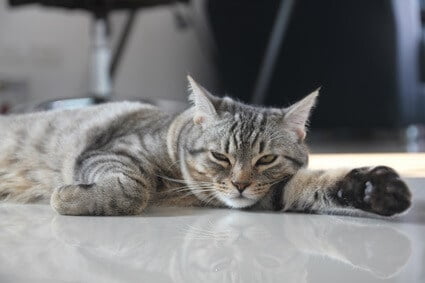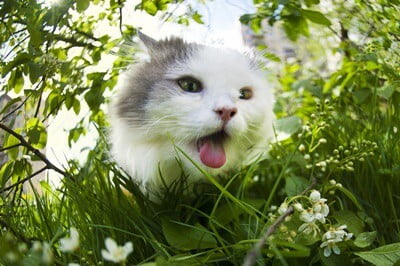The summer heat can be hard on cats, so we must ensure they stay comfortable. The temperatures that cats can cope with are different from those that humans can tolerate. So, you should keep that in mind when assessing how your cat is coping.
Cats have higher body temperatures than humans, so they can tolerate hotter temperatures. However, the ideal temperature for a cat shouldn’t surpass 100°F. The optimal temperature for long-haired and short-haired cat breeds is between 75°F and 80°F.
Cats won’t come to you directly when something is wrong. To protect your cat from heatstroke and dehydration, keep a close eye on the temperature indoors and outdoors.
Can Cats Handle Hot Weather?
Cats can handle hotter weather better than we can because their average body temperature sits between 100°F and 102.5°F, whereas humans have an average temperature of 98.6°F. However, things become more dangerous if the temperature surpasses their average body temperature.
A cat is unlikely to die suddenly when the temperature rises above 100°F, and a healthy cat can survive as long as it has sufficient water.
Also, cats have a better chance of regulating their body temperature if they’re accustomed to hot weather. According to Developmental Psychobiology, cats become homeothermic if exposed to certain temperatures from a young age.
Still, it’s important to monitor your cat if dry-bulb temperatures rise above 100°F as dehydration and heatstroke are significant risks past that point.
If the temperature goes above 105°F, do what you can to cool your cat down.
How Does Heat and Humidity Affect Cats?
When ensuring that temperatures are optimal for your cat, humidity is just as important as the heat levels of the environment. Depending on the humidity level, your cat will dehydrate or get heatstroke.
Cats have sweat glands to help them cool off and regulate their body temperature. Under normal conditions, the sweat pulls the heat from the cat’s body as it evaporates. However, this effective biological mechanism causes problems if the environment is excessively dry or humid.
When the environment is too hot and dry, the cat loses too much water, resulting in dehydration. However, if there’s too much humidity, the sweat won’t be able to evaporate fast enough.
Because there’s already too much moisture in the air, there will be no extra capacity for the cat’s sweat. If the cat can’t expel enough moisture, its body won’t cool down, resulting in heatstroke.
The index that measures heat and humidity is called the wet-bulb temperature. No formal studies have determined the maximum wet-bulb temperature cats can tolerate. However, we can make an estimate because the max wet-bulb temperature humans can tolerate is a maximum temperature of 95°F.
It’s possible that cats can tolerate a higher wet-bulb temperature than humans. Once the wet-bulb temperature begins to climb toward 90°F, you need to cool your cat down.
You can measure the wet-bulb temperature by wrapping a thermometer bulb in a wet cloth. Either that or you can use a calculator that uses relative humidity and temperature to find a solution.

How to Tell If Your Cat is Too Hot
As summer rolls around and the temperature rises, you must ensure that your cat won’t experience heat-related health problems and physical ailments.
When your cat is dehydrated or has heat stroke, it’ll display the following symptoms:
- Vomiting
- Sweaty paws
- A body temperature over 105°F
- Lethargy
- Panting
- A rapid heartbeat
- Tremors
- Seizures
- Drooling
- Red gums
- Dizziness
- Restlessness
- Aggression
- Loss of appetite
- Hot stomach and underarms
Even if temperatures have yet to reach 100°F, if your cat is a long-haired breed, you should check for signs of dehydration and heatstroke.
Long-haired breeds like Birmans and Persian cats have long coats because they come from places where nights are cold, or there’s a seasonal winter.
They don’t do well in extreme heat. Their long coats obstruct their sweat glands too much, meaning they can’t cool down as easily as other cat breeds.
Indoor Cats in Summer
Even if your cat doesn’t go outside during the hot summer months, it’s still important to keep the indoor temperature cool.
Domestic cats love the warmth and are always seeking it out. That’s why sunbathing is their favorite pastime, and they never let an opportunity to lay on a warm patch of sunlight go to waste.
However, this instinct can lead to problems. Lying in the sun causes the cat’s body temperature to rise. Before the cat realizes it, its body temperature could reach critical levels. If the rest of the house isn’t cool enough, it’ll have trouble returning its body temperature to normal levels.
Monitor your cat during the summer, even if it stays indoors. If you have to leave your cat alone for hours, close the curtains and keep the AC on.
What Room Temperature is Too Hot for Cats?
Cats can’t tolerate a temperature above 100°F.
Past that point, they run the risk of overheating since the environment is raising their body temperature. They also have trouble keeping cool once the wet-bulb temperature nears 95°F.
During stifling weather, ensure there’s at least one room in your house where your cat can cool off.
Usually, the coolest rooms in your home will be on the first floor since heat naturally rises. Shady rooms where sunlight doesn’t enter are usually cold, so keep your cat in those areas.
How Hot is Too Hot for Cats Outside?
Cats that love the outdoors need to be kept inside during very hot weather. If outdoor temperatures go above 100°F and the relative humidity is high, a cat is at risk of experiencing heatstroke.
A cat being outdoors while temperatures are high is dangerous. Direct exposure to sunlight will elevate the cat’s body temperature by much more than it can handle.
Even if the cat stays in the shade, the sun’s heat can get reflected off objects on the ground, and that heat will affect your cat after being outdoors for too long.
Leaving out water won’t work either since the heat will warm it up. Though it does help with dehydration, warm water entering the body of an already warm cat won’t help it cool down.
Frequently check the temperature during summer. Sometimes, we can’t accurately tell how hot it is outside because we spend our time in houses, cars, and offices with the AC on.
So, even if it doesn’t feel that hot to you, don’t leave your cat outside if you live in an area where temperatures get high.
Older Cats and Hot Weather
Older cats fair much worse in hot weather than younger cats.
As their body gets weaker and they begin to develop organ problems, it’s more important than ever that their body remains at an even temperature and an adequate hydration level.
Certain ailments, such as kidney failure, can discourage cats from drinking water, which heightens the risk of dehydration during warm weather. As senior cats have weaker organs, the likelihood that they’ll shut down due to heatstroke is higher.
Cats are considered seniors once they’re 11 years old. If you have a cat around this age, be extra vigilant during summer, even if it seems happy and healthy.
If your cat is being treated for an illness, watch for signs of heat-related problems.
Which Cats Don’t Tolerate Heat Well?
Aside from being old and having long coats, other factors can make it difficult for a cat to tolerate heat.
Such cats won’t thrive in temperatures above 95°F, so you need to help cool them down even when the temperature doesn’t seem that hot to you.
Obese Cats
Obese cats maintain higher body temperatures than cats that are a healthy weight. This means that it’s easier for them to overheat and much harder to cool down.
Brachycephalic cats
Cats with a short snout have difficulty breathing. When their environment is hot and humid, they can’t breathe properly, resulting in excessive panting and dehydration.
Kittens
Kittens can’t regulate their body temperature until they’re 4 weeks old. To cool off, they rely on their mother to lick and groom them. As the saliva evaporates, it cools their body down.
How Do Cats Cool Themselves Off?
Cats cool themselves off by sweating, sleeping, grooming, and panting.
Cats have sweat glands in certain parts of their bodies. Most of it is covered in fur, so the sweat glands that have the greatest cooling effect are on the paws.
According to Science, cats can lower their body temperature when asleep. Cats will also groom themselves more in the summer since the saliva evaporating off their body provides a cooling effect.
Also, they pant when things get too hot to allow the saliva to evaporate off the tongue.
How to Keep Cats Cool During the Summer
To avoid dehydration and heatstroke in cats, you can do the following:
- Leave the AC on
- Encourage drinking by providing fresh running water, not still water
- Get a cooling mat
- Close the curtains to keep the house cool
- Groom your cat with a wet cloth
If your cat’s body heat keeps rising, contact a vet for guidance. A health issue can prevent your cat from regulating its body heat properly, such as sweat gland tumors.

